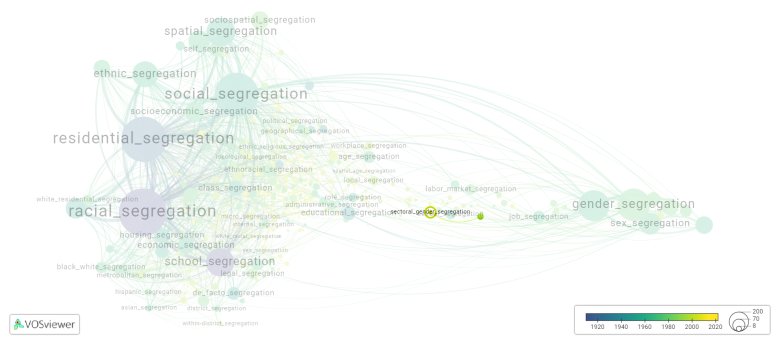Sectoral gender segregation: Difference between revisions
(Creating page) |
(Creating page) |
||
| (8 intermediate revisions by the same user not shown) | |||
| Line 10: | Line 10: | ||
Efforts to reduce sectoral gender segregation include promoting diversity and inclusion in the workplace, providing equal access to education and training programs, and implementing policies that address gender-based discrimination and biases. By breaking down barriers and promoting fair opportunities for all individuals, we can work towards a more equitable and inclusive society. | Efforts to reduce sectoral gender segregation include promoting diversity and inclusion in the workplace, providing equal access to education and training programs, and implementing policies that address gender-based discrimination and biases. By breaking down barriers and promoting fair opportunities for all individuals, we can work towards a more equitable and inclusive society. | ||
==See also== | ==See also== | ||
==Related segregation forms== | |||
Sectoral gender segregation is frequently discussed in the literature with the following segregation forms: | |||
[[sectoral segregation]], [[gender segregation]] | |||
[[File:sectoral_gender_segregation.png|780x780px]] | |||
This visualization is based on the study [[Segregation_Wiki:About| The Multidisciplinary Landscape of Segregation Research]]. | |||
For the complete network of interrelated segregation forms, please refer to: | |||
* [https://tinyurl.com/2235lkhw First year of publication] | |||
* [https://tinyurl.com/2d8wg5n3 Louvain clusters] | |||
* [https://tinyurl.com/223udk5r Betweenness centrality] | |||
* [https://tinyurl.com/244d8unz Disciplines in which segregation forms first emerged (Scopus database).] | |||
==References== | ==References== | ||
==Notes== | ==Notes== | ||
<references /> | <references /> | ||
{{NoteAI}} | {{NoteAI}} | ||
==Sectoral | ==Sectoral gender segregation appears in the following literature== | ||
Van Puyenbroeck T., De Bruyne K., Sels L. (2012). More than 'Mutual Information': Educational and sectoral gender segregation and their interaction on the Flemish labor market. ''Labour Economics'', ''19''(1), 1-8. https://doi.org/10.1016/j.labeco.2011.05.002 | Van Puyenbroeck T., De Bruyne K., Sels L. (2012). More than 'Mutual Information': Educational and sectoral gender segregation and their interaction on the Flemish labor market. ''Labour Economics'', ''19''(1), 1-8. https://doi.org/10.1016/j.labeco.2011.05.002 | ||
| Line 22: | Line 39: | ||
Buribayev Y.A., Khamzina Z.A. (2019). Gender equality in employment: The experience of kazakhstan. ''International Journal of Discrimination and the Law'', ''19''(2), 110-124. SAGE Publications Ltd.https://doi.org/10.1177/1358229119846784 | Buribayev Y.A., Khamzina Z.A. (2019). Gender equality in employment: The experience of kazakhstan. ''International Journal of Discrimination and the Law'', ''19''(2), 110-124. SAGE Publications Ltd.https://doi.org/10.1177/1358229119846784 | ||
Barba I., Iraizoz B. ( | Barba I., Iraizoz B. (202). Effect of the great crisis on sectoral female employment in Europe: A structural decomposition analysis. ''Economies'', ''8''(3), -. MDPI AG.https://doi.org/10.3390/ECONOMIES8030064 | ||
Batchuluun A. (2021). The gender wage gap in Mongolia: Sectoral segregation as a driving factor. ''Review of Development Economics'', ''25''(3), 1437-1465. John Wiley and Sons Inc.https://doi.org/10.1111/rode.12763 | Batchuluun A. (2021). The gender wage gap in Mongolia: Sectoral segregation as a driving factor. ''Review of Development Economics'', ''25''(3), 1437-1465. John Wiley and Sons Inc.https://doi.org/10.1111/rode.12763 | ||
Latest revision as of 07:17, 16 October 2024
Date and country of first publication[1][edit | edit source]
2012
Belgium
Definition[edit | edit source]
Sectoral gender segregation refers to the phenomenon where certain industries or sectors of the economy are predominantly dominated by either men or women. This segregation occurs due to various factors such as societal norms, cultural beliefs, discrimination, and limited access to educational and economic opportunities.
For example, sectors such as construction, engineering, and technology are typically male-dominated, while sectors like healthcare, education, and social services are often female-dominated. This segregation can lead to unequal opportunities, pay disparities, and limited career advancement for individuals based on their gender.
Efforts to reduce sectoral gender segregation include promoting diversity and inclusion in the workplace, providing equal access to education and training programs, and implementing policies that address gender-based discrimination and biases. By breaking down barriers and promoting fair opportunities for all individuals, we can work towards a more equitable and inclusive society.
See also[edit | edit source]
Related segregation forms[edit | edit source]
Sectoral gender segregation is frequently discussed in the literature with the following segregation forms:
sectoral segregation, gender segregation

This visualization is based on the study The Multidisciplinary Landscape of Segregation Research.
For the complete network of interrelated segregation forms, please refer to:
References[edit | edit source]
Notes[edit | edit source]
- ↑ Date and country of first publication as informed by the Scopus database (December 2023).
At its current state, this definition has been generated by a Large Language Model (LLM) so far without review by an independent researcher or a member of the curating team of segregation experts that keep the Segregation Wiki online. While we strive for accuracy, we cannot guarantee its reliability, completeness and timeliness. Please use this content with caution and verify information as needed. Also, feel free to improve on the definition as you see fit, including the use of references and other informational resources. We value your input in enhancing the quality and accuracy of the definitions of segregation forms collectively offered in the Segregation Wiki ©.
Sectoral gender segregation appears in the following literature[edit | edit source]
Van Puyenbroeck T., De Bruyne K., Sels L. (2012). More than 'Mutual Information': Educational and sectoral gender segregation and their interaction on the Flemish labor market. Labour Economics, 19(1), 1-8. https://doi.org/10.1016/j.labeco.2011.05.002
Kis-Katos K., Pieters J., Sparrow R. (2018). Globalization and Social Change: Gender Specific Effects of Trade Liberalization in Indonesia. IMF Economic Review, 66(4), 763-793. Palgrave Macmillan Ltd..https://doi.org/10.1057/s41308-018-0065-5
Buribayev Y.A., Khamzina Z.A. (2019). Gender equality in employment: The experience of kazakhstan. International Journal of Discrimination and the Law, 19(2), 110-124. SAGE Publications Ltd.https://doi.org/10.1177/1358229119846784
Barba I., Iraizoz B. (202). Effect of the great crisis on sectoral female employment in Europe: A structural decomposition analysis. Economies, 8(3), -. MDPI AG.https://doi.org/10.3390/ECONOMIES8030064
Batchuluun A. (2021). The gender wage gap in Mongolia: Sectoral segregation as a driving factor. Review of Development Economics, 25(3), 1437-1465. John Wiley and Sons Inc.https://doi.org/10.1111/rode.12763
